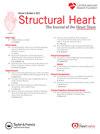Successful Transseptal Transcatheter Aortic Valve Replacement With Monitored Anesthesia Care and Standard Delivery System
IF 1.4
Q3 CARDIAC & CARDIOVASCULAR SYSTEMS
引用次数: 0
Abstract
Transcatheter aortic valve replacement (TAVR) has emerged as a viable treatment option for patients with symptomatic aortic stenosis across all surgical risk groups. Although the need for alternative access to transfemoral access is becoming less frequent due to better device profiles, there is a continued need for such options. Common approaches used today include subclavian, carotid, caval, aortic, or apical. However, the transseptal approach has not been described with the current S3 delivery system. We present, to our knowledge, the first reported case of a transseptal TAVR using the standard delivery system and under monitored anesthesia care (MAC). This case demonstrates that advances in maneuverability and device profile make transseptal delivery of the S3 valve a safe and effective approach in some patients with no other peripheral arterial access.
通过监测麻醉护理和标准输送系统成功实施经皮主动脉瓣置换术
经导管主动脉瓣置换术(TAVR)已成为所有手术风险组症状性主动脉瓣狭窄患者的可行治疗选择。虽然由于更好的设备配置,需要替代经股动脉通路的频率越来越低,但仍然需要这种选择。目前常用的入路包括锁骨下入路、颈动脉入路、腔静脉入路、主动脉入路或根尖入路。然而,目前的S3给药系统尚未描述过经隔膜入路。据我们所知,我们报告了第一例使用标准输送系统和监测麻醉护理(MAC)的经隔膜TAVR病例。该病例表明,可操作性和设备外形的进步使得S3瓣膜经间隔输送在一些没有其他外周动脉通道的患者中成为一种安全有效的方法。
本文章由计算机程序翻译,如有差异,请以英文原文为准。
求助全文
约1分钟内获得全文
求助全文
来源期刊

Structural Heart
Medicine-Cardiology and Cardiovascular Medicine
CiteScore
1.60
自引率
0.00%
发文量
81
 求助内容:
求助内容: 应助结果提醒方式:
应助结果提醒方式:


